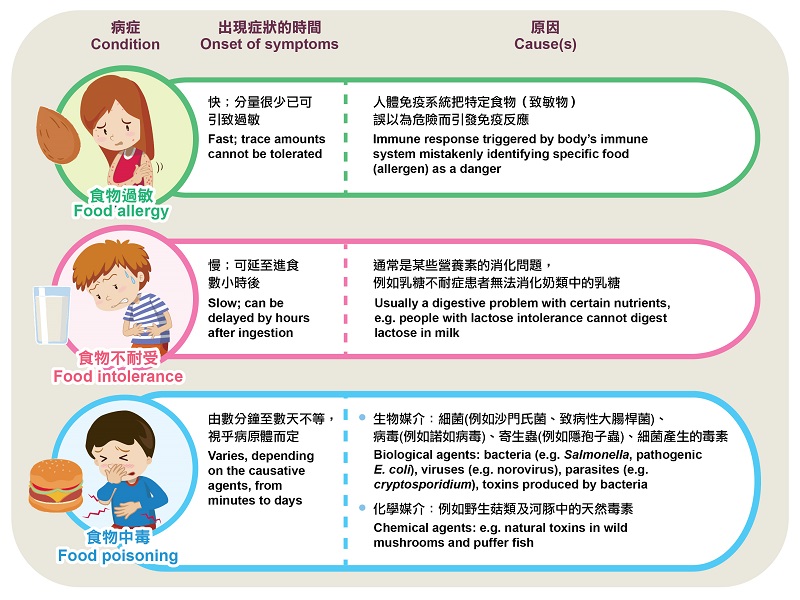
Food Safety Focus (192nd Issue, July 2022) – Article 1
Allergy to Undercooked Meat? A Look into Food Allergy,
Food Intolerance and Food Poisoning
Reported by Ms. Melva CHEN, Scientific Officer,
Risk Communication Section, Centre for Food Safety
The Centre for Food Safety undertook a study to evaluate food handlers’ knowledge, attitudes and behaviours regarding the preparation of beef burgers and taking into account the study findings, issued the Trade Guidelines on Safe Preparation of Beef Burgers. During interviews with food handles, some who served undercooked patties thought that sick customers might have an ‘allergic reaction’ after eating their burgers rather than a foodborne disease, often known as food poisoning. Some handlers believed that burger patties made from expensive beef, like wagyu, could be eaten raw or lightly cooked. This article dispels such myths and emphasises the need of thorough cooking to kill microorganisms, especially in mince, that might cause food poisoning.
Food Allergy and Food Intolerance
Food allergy is an unusual immune system reaction that occurs rapidly after eating certain foods. The immune system normally defends the person from pathogens, but in the case of food allergies, it misinterprets the food as dangerous. Even minimal allergen exposure might result in unpleasant symptoms such as vomiting, stomach discomfort, hives or swollen airways within minutes to an hour after eating. Anaphylaxis is a severe immunological reaction that sends a person into shock. Common food allergens include milk, eggs, peanuts, tree nuts, soy, wheat, seafood and shellfish. While avoiding the food allergen is the primary way to avoid a reaction, having the correct information, such as allergen labelling, helps making safe food choices.
Food intolerance is a less serious condition; instead of the immune system, it is typically limited to digestive problems. Lactose (milk sugar) intolerance, for instance, is a digestive disorder caused by the deficiency of lactase, an enzyme that digests lactose. While a person with lactose intolerance is unable to digest lactose, the bacteria in the gut consume it, causing bloating, stomach discomfort and diarrhoea. People with food intolerance may be able to have trace quantities of the offending food without a problem. They may avoid unpleasant responses by watching out for what they eat. Lactose-free milk or plant-based milk alternatives, for example, may be appropriate for a lactose intolerant person.
Food Poisoning
While not all people have food allergies or intolerances, they are at risk of having food poisoning if they consume food contaminated with bacteria, viruses, parasites or chemicals (Figure 1). Harmful bacteria or their toxins can contaminate food at any stage of production, particularly if food is handled or cooked improperly. Common symptoms of food poisoning include abdominal pain, diarrhoea, nausea and vomiting, which can last from hours to days depending on the causative agent. Individuals who are vulnerable, such as the elderly, babies and young children, pregnant women and anyone with weakened immunity, may have severe sequalae and life-threatening conditions. Bacteria are the most common cause of food poisoning in Hong Kong. In 2021, the three most prevalent contributing factors to food poisoning in local food premises were contamination of cooked food by raw food, consumption of raw food and inadequate cooking. To effectively reduce microbiological threats, cook meat, poultry, fish and eggs to an internal temperature of at least 75°C to help guarantee that they are safe for eating.

Figure 1: Differences between food allergy, food intolerance and food poisoning
Why Burger Patties Should Not be Eaten Raw or Lightly Cooked?
The surface of meat can be contaminated by harmful bacteria such as Salmonella and pathogenic E. coli. during slaughtering and handling. For a steak which is an intact cut of beef, the inside usually does not contain bacteria. Searing the outside surface of the steak can kill the surface bacteria. However, when meat is minced to produce burger patties, any harmful bacteria present on the surface of the raw meat will be spread throughout the patty. Unless the burger patty is cooked right through, these bacteria can remain alive on the inside. Since food poisoning organisms are prevalent throughout the food chain, this happens to all burger patties, including those made from good quality or expensive meat.
Food Safety First
Food handlers who mistake food poisoning for food allergy may overlook food safety practices because they are not aware that the adverse conditions of their customers upon eating undercooked burgers are due to bacteria contamination. It is important for food handlers to know the cause of food poisoning and prevent it by practising food safety. The “5 Keys to Food Safety” are five simple and effective practices for people to follow when handling food to prevent foodborne diseases: Choose (choose safe raw materials); Clean (keep hands and utensils clean); Separate (separate raw and cooked food); Cook (cook thoroughly); and Safe Temperature (keep food at safe temperature).

